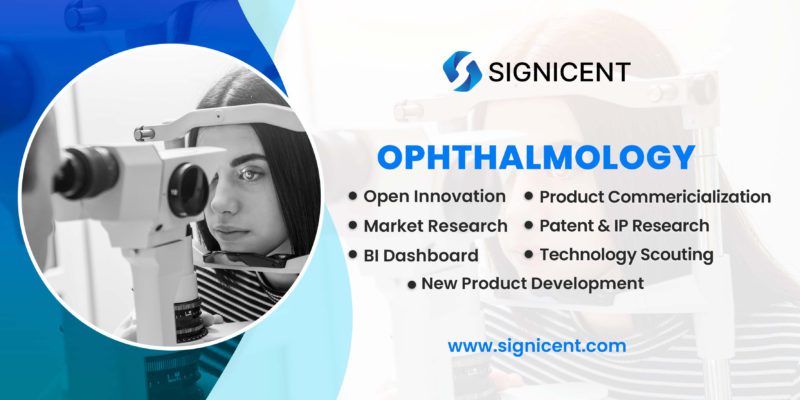The Ophthalmology Report explores the field of telehealth in Ophthalmology. The ophthalmology report is aimed at identifying potential areas and key opportunities in the field of telehealth and optical care. Some light is shed on identifying competitors, key players, and associated emerging technologies. Additionally, the competitive perspective along with market analysis has been summarised.
Telehealth is a rapidly growing field in ophthalmology, and new technologies can better treat, manage and monitor the progression of ophthalmic diseases.
Tele-health devices are monitoring patients’ ocular conditions in real-time, often through mobile apps on patients’ smartphones or tablets. This real-time monitoring allows up-to-date ocular condition information for the clinician and is less burdensome for the patient who may not have to go to a clinic.
The simultaneous maturation of multiple digital and telecommunications technologies in 2020 has created an unprecedented opportunity for ophthalmology to adapt to new models of care using telehealth supported by digital innovations.
These digital innovations include artificial intelligence (AI), 5th generation (5G) telecommunication networks, and the Internet of Things (IoT), creating an inter-dependent ecosystem offering opportunities to develop new models of eye care.
Telemedicine is more than just taking a picture of the back of an eye and then someone reading it to provide a diagnosis and management plan. It takes training to be able to accurately diagnose a condition through a digital image or another testing.
Key Assignee in Tele-health Ophthalmology
In this section of the ophthalmology report, the key assignee has been discussed. J&J/AMO is actively working in the area of telehealth, especially in workflow management and diagnostics. Workflow management it is focusing on communication channels and medical records management, and diagnostics it focusing on predictive analysis.
Predictive IOP Algorithm
The static IOP and dynamic IOP of a patient’s eye can fluctuate greatly during an ophthalmic surgical procedure. The flow of fluid from the patient’s eye and pressure through the handpiece are critical. Thus, it is necessary to maintain a stable volume of liquid in the anterior chamber of the eye. This report on Opthalmology provides a possible solution.
A method to determine by IOP using an algorithm that is a function of the static (inflow) pressure and/or dynamic (outflow) pressure, which can be calculated using various parameters like bottle height, aspiration rate, tip size.
By applying a predictive IOP algorithm by a computing memory associated with a processor, static and dynamic intraocular pressure can be determined which is further helpful in surgery. The algorithm will be taking into account various surgical settings that account for fluid inflow and fluid outflow in order to predict a total IOP.
Predictive Analytics
IBM is also actively working in the area of workflow management and diagnostics. Its workflow management includes communication channels such as Wide Area Network (WAN), DICOM, Internet and Local Area Network (LAN), and storage of management of medical records, billing, and servicing. It is also working on a computer program based on predictive analytics for diagnostics in the domain of telehealth ophthalmology.
As computers have become critical tools in the modern economy, computer-related eyestrain has become a major problem associated with the workplace. The ophthalmology report discusses the use of predictive analytics.
A system to monitor visual health including a processor operatively coupled to a memory. The system further includes one or more subsystems configured to record data related to eye health. The processor is configured to analyze the recorded data, detect a likelihood of eyestrain based on the analysis, and generate an alert to perform at least one action in response to the detection and based on at least a portion of the recorded data.
By examining both sets of 2D (e.g., glare by luminance cameras and computer display settings) and 3D (e.g., a positioning of a user, light/level angle) parameters, a more accurate conclusion regarding the eye condition of a user may be drawn.
Three-dimensional Model
Cataract extraction is a frequently performed surgical procedure. There is a need to combine or fuse data sets from different devices to obtain a single, three-dimensional model of the patient’s eye. The opthalmology report hereby provides a method.
An optical measurement system for carrying out cataract diagnostics, including a Corneal Topography Subsystem, a wavefront aberrometer subsystem, and an eye structure imaging subsystem, wherein the subsystems have a shared optical axis, and each subsystem is operatively coupled to the others via a controller.
The system is able to store intraocular lens data for IOL models having predetermined parameters selected from the group consisting of dioptic power, anterior and posterior radius, IOL thickness, refractive index, asphericity, and lens filter. The system includes a processor configured to execute an algorithm.
The algorithm comprises: modeling the subject’s eye with an intraocular lens corresponding to the IOL model, determining a desired postoperative condition of the subject’s eye; empirically calculating a post-operative condition of the subject’s eye.
Remote Health Tracking Management Software
Interactions between patients and physicians have traditionally been episodic. Therefore, the ophthalmology report discusses a methodology to overcome health tracking issues. Patients may visit more than one physician for the same complaint or consult different specialists for different complaints. A physician often does not have ready access to data that has been obtained by other physicians. The program comprises a non-transitory computer-readable medium having computer-executable instructions stored for tacking health.
Cordination Issues In Healthcare System
The conventional healthcare system is considered inefficient, inconvenient, and often fails to ensure good outcomes to treatment. Reasons can be lack of coordination or lack of timely access. One of the chief problems in the early detection of eye damage. There are privacy and security concerns associated with Telehealth that can adversely affect patients’ and clinicians’ level of trust and willingness to adapt and use the system.
Care Coordination Software Platform
The telemedicine system includes a care coordination software platform that allows patient monitoring at home. It also connects patients to medical teams via telemedicine that is augmented remotely. The ophthalmology report shares information about a moderate, cost-effective, and portable system that provides high contrast digital images by scanning laser devices operating with near-infrared illumination.
Technical controls like Data Encryption where data are electronically “locked” using complex mathematics and adoption of Health Insurance Portability and Accountability Act (HIPPA) privacy and security regulations.
Tele-health Innovation in Ophthalmology
Modernizing Medicine, Inc., is a US-based software company. The company offers electronic health records, practice management, revenue cycle management, and data analytics for doctors.
Modmed 5.0 is a comprehensive specialty-specific suite to help transform the clinical, financial, and operational aspects of specialty practices. Specialty-specific EMR provider, Modernizing Medicine has unveiled the latest edition of its EMR software.
The new generally available product offerings and enhancements for modmed 5.0 include:
- Practice management helps in designing practice workflows and boosting patient payments. modmed telehealth rather than trying to practice through text messages. The physicians can have a richer engagement with patients through Modernizing Medicine’s telemedicine platform.
- Document and bill pathology reports seamlessly with this automated and intuitive pathology module. Enhancements include Practice Management, an all-in-one system for scheduling, document management, billing, and reporting designed to help improve practice workflows and clinical lab integrations with Quest and Labcorp.
Practice Management Software
Nextech’s two forward-thinking ophthalmology EMR solutions are built to meet the varying needs of any ophthalmology clinic with the promise of unmatched efficiency.
Through the pre-configured, customizable templates of Nextech’s client-server EMR or the intuitive, adaptive templates of the SaaS solution, IntelleChart, Nextech understands what ophthalmologists need out of their EMR software.
Key Features include:
- Reporting and analytics provide real-time business insight.
- Adaptable templates and predictable content streamline charting.
- Advanced scheduling handles single or multi-location practices
- Patient portal and mobile app improve patient engagement.
- Manage the health of your practice by leveraging real-time insightful business intelligence.
- Subspecialty charting features like Glaucoma Flowsheet and Cataract Surgery Planner support unique specialty workflow and documentation needs.
IBM Watson Health
IBM Watson Health, US is a division of the International Business Machines Corporation, (IBM), an American multinational information technology company.
It helps clients facilitate medical research, clinical research, and healthcare solutions, through the use of artificial intelligence, data, analytics, , cloud computing, and other advanced information technology.
IBM Watson to pull the plug on Merge Eye: Topcon Healthcare Solutions, a leading provider of medical devices and software solutions for the eye care community, announced that it is partnering with IBM Watson Health Imaging in an effort to support a transition plan for their Merge Eye Station™ digital fundus imaging platform and the Merge Eye Care PACS™ web-based image management system, two products from their global eye care division.
IBM Watson Health’s Big Data Analytics and Cognitive Computing will empower ophthalmologists worldwide to dynamically and continuously keep up to date and practice an innovative highly personalized, knowledge-based, and patient-centered brand of eye care.
Eye-Tracking Technology
Eye Tracking (ET) is a sensory technology that enables the detection and measurement of the gaze point (eye position and movement). ET devices are either screen-based (remote) or glasses/head-mounted and consist of micro projectors and a custom-designed camera that are integrated with advanced image-processing and mathematical algorithms. The projectors create a pattern of near-infrared light on the user’s eyes, the sensors capture high-frame-rate images, and the image algorithm process the reflection patterns, to calculate the eye’s position and gaze direction.
Portable Retinal Camera
The reference provides a retinal camera that can be used non-mydriatically. It will not require the presence of a physician or use of the pupil-dilating drops. So eye exams may be performed by visiting nurses, health-maintenance technicians, and other practitioners with limited training. The multiple branch optical system is present, which comprises a variable power optical element that varies the focus of the incoming light, and an image display.
Recent Advancements in Tele-health
RetinaVue Care Delivery Model: 95% of vision loss due to diabetic retinopathy can be prevented with early detection. In view of that Welch Allyn(-US-based) (Hillrom) developed workflow management for the early detection of diabetic retinopathy.
This easy-to-use smart camera offers an automated retina imaging experience, featuring auto-alignment, auto-focus, and auto-capture. And it provides you with flexible options for your workflow, including EMR connectivity and WiFi for efficient information transfer and seamless integration.
Each year Signicent provides consultancy to hundreds of organizations to help transform their innovations to value.
Smartphone-Based Ophthalmic Refractometer
Smartphone-based vision testing: Based on an MIT patent, EyeQue’s (US-based health company) VisionCheck, an ophthalmic refractometer is developed to measure how well the uncorrected eye focuses. The optical principle behind the VisionCheck is called Inverse Shack Hartmann. Once the series of tests are completed, the results are instantly processed and analyzed using powerful algorithms in the EyeQue Cloud. The results are viewed on the user’s mobile app or on their personal online dashboard at eyeque.com
Gobiquity
Gobiquity, Inc. (US) develops mobile application software. The Company offers an application for the detection and prevention of health disorders and chronic diseases.
Gobiquity launched their flagship innovation, GoCheck Kids™, last year, the world’s first and only pediatric vision screener on a smartphone, incorporating a cloud-based HIPAA compliant platform that screens a child’s eyes for risk factors that lead to vision loss.
It overcomes the following challenges of kids’ vision screening:
- Capital intensive
- Non-integrated
- Difficult to scale
- Hard to operate
Visual Acuity
The GoCheck Kids digital visual acuity test alleviates clunky wall chart workflows, removes tester bias, and eliminates the ability to cheat. It employs standardized protocols based on national guidelines with results independent of the administrator’s vision screening experience.
OutcomeMD
OutcomeMD (US), is a digitally focused company that aims to capture patient-reported outcomes (PROs) in a simple and engaging way. OutcomeMD has developed clusters of multiple PROs based on validated medical literature. The company’s software delivers a practical tool that rewards doctors, patients for collecting and utilizing patient-reported outcome data to inform treatment decisions and dial in best practices, enabling doctors to cure identification and predictive analytics.
The Comprehensive Workflow
Provide comprehensive care management by using patient-reported outcome (PRO) data to identify possible clinical pathways post-surgery on patients who completed PRO measures to assess dry eye and visual symptoms before and after LASIK surgery, nearly half reported new visual symptoms post-surgery.
Identify and engage in best practices to meet patient needs. The use of PROM data contributed to the NICE guideline recommending bevacizumab for the treatment of age-related macular degeneration. Collecting PRO data before and after cataract surgery revealed large variations in data, influenced by factors including the degree of anisometropia, indication for surgery, and postoperative problems.


